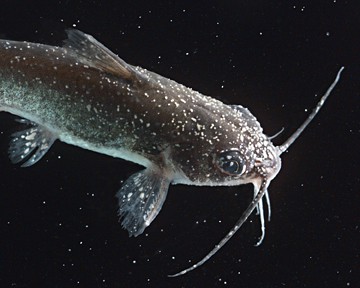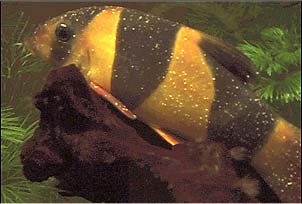The name Ichthyophthirius Multifilis translates to “fish louse with many children”, a title that fits well, as each parasite may produce over a thousand offspring. Although the disease is the equivalent of a skin infection, Ich (sometimes called Ick) can easily be fatal to a fish stressed by poor diet or habitat. The key is prevention, but that is another matter if the fish are already infected with Ich.

Symptoms:
- Small white spots resembling sand or sugar granules (see above picture)
- Fish scratch against rocks and gravel
- In advanced stages fish become lethargic
- Redness or bloody streaks
- Clamped fins
- Fish gasping at the water’s surface
Infected fish are covered to various degrees with small white spots. Severe infestations are easy to spot, but small occurrences often go unnoticed. However, ich won’t remain unnoticed for long. Like a bad penny, it will be back with a vengeance. The adult parasite burrows into the skin of its victim, feeding on blood and dead epithelial cells. The irritation caused by the burrowing parasite causes the skin of the fish to swell and produce white cysts seen as a small spots.
The fish feels as if it’s been bitten by a mosquito. It’s not unusual to see infected fish scratching against rocks and gravel in an effort to get relief.
After several days of feasting, the engorged parasite develops into a trophozoite, burrows out of the fish and sinks bottom of the tank. Secreting a soft jellylike substance, it forms a protective membrane inside of which it divides into hundreds of baby parasites, known as tomites. The hungry tomites soon leave their home in search of a fresh fish to dine upon. It is during the free-swimming stage, which lasts a mere three days, that the parasite is vulnerable to medication. Once it has burrowed into a new host fish it is safely protected from chemicals in the water.
Treatment:
- Raise water temperature to at least 80 degrees Fahrenheit and increase oxygenation
- Medicate for 10-14 days
- Reduce medication when treating scaleless fish
- Discontinue carbon filtration during treatment
- Perform water changes between treatments
The entire cycle can take up to two weeks from start to finish. Higher temperatures will shorten the cycle, while low temps lengthen it. Therefore, raising the water temperature shortens the time it takes for the parasite to reach the stage in which it is susceptible to medication.
Treatments must be given for a long enough period to assure that all parasites are gone. Watch carefully for other infections, as secondary infections often occur where the skin has been damaged by the parasite.
Although nothing kills the parasite once it has checked into it’s fish “hotel”, several chemicals kill ich once it has left the fish. Malachite green, methylene blue, quinine hydrochloride, and mepracrine hydrochloride are all effective, and are available under several brand names.
Dose based on the package instructions, however cut dosages in half or use an alternate treatment when treating scaleless catfish and tetras. Regardless of the medication used, treatment should be given continuously for 10-14 days to ensure all parasites are killed. Between treatments a partial water change is recommended. Keep water temperatures higher than usual to speed up the life cycle of the parasite. Discontinue carbon filtration during treatment, as it will remove the chemicals.
Prevention:
- Maintain a consistent temperature with a variation of 2 degrees F or less preferable
- Quarantine new fish for two weeks in a hospital tank
- Treat plants before adding to tank
- Maintain high water quality, with frequent water and filter changes
- Provide fish with a nutritionally balanced and varied diet
The best way to avoid ich is to quarantine all new fish in a separate tank for two weeks before moving them to the regular tank. When quarantine is not possible, a prophylactic treatment may be used. Either methylene blue or malachite green given when new fish are introduced and again four days later will help reduce incidence of infection. New plants should also be treated, as they can carry ich cysts.
Do not use methylene blue or malichite green on scaleless fish, such as Clown Loaches!

Maintaining high water quality, avoiding temperature fluctuations, and providing a robust diet is the best preventative for ich (ick) from attacking your tropical fish.
Tropical Fish Site takes no responsibility for diagnosing the exact problem with your tropical fish, this is purely meant as a guide only. Be sure to look at other common tropical fish diseases to ensure you have made the correct diagnosis as there is often crossover between them.
Waterlife Protozin Whitespot/Fungus Treatment, 100 ml
Features:- always follow package guidelines
- water treatment for improving fish water quality
- helps to cure common ailments found in aquariums
- Model number: 5568
Waterlife Protozin 250ml
Features:- Do not use when rays or momyrids are present.
- Suitable for tropical freshwater and coldwater aquaria.
- 250ml treats 625 litres (4 day course)






Related Posts
A Deeper Look In To Loach Fish Species
How Much Salt Should I Add To My Freshwater Aquarium
Everything You Need To Know About Using T5 Lights For Your Aquarium